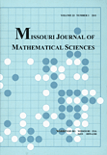
Missouri Journal of Mathematical Sciences
Scope & Guideline
Fostering Ideas, Fueling Mathematical Progress
Introduction
Aims and Scopes
- Pure and Applied Mathematics:
The journal explores both pure mathematical theories and their applications in various fields, including engineering, physics, and data science. - Algebra and Number Theory:
Research in algebraic structures, including rings, modules, and ideals, is a core focus, reflecting the journal's commitment to deepening the understanding of mathematical foundations. - Topology and Analysis:
The journal publishes studies on topological spaces, continuity, and convergence, emphasizing both classical and modern approaches to analysis. - Combinatorics and Graph Theory:
A significant portion of the journal's content addresses combinatorial mathematics and graph theory, contributing to the development of algorithms and complex structures. - Mathematical Modeling and Computational Methods:
The inclusion of papers on mathematical modeling and computational techniques highlights the journal's role in bridging theoretical mathematics with practical applications in technology and science.
Trending and Emerging
- Applications of Advanced Calculus and Analysis:
Recent papers have increasingly focused on the applications of calculus in solving complex problems, such as approximating functions and analyzing series, demonstrating the growing importance of these techniques in modern mathematics. - Fuzzy Logic and Its Applications:
The rise of research on fuzzy ideals and fuzzy structures indicates a growing interest in uncertainty and imprecision in mathematical modeling and decision-making processes. - Interdisciplinary Approaches:
There is a notable trend towards interdisciplinary studies that combine mathematics with fields such as neuroscience and computer science, highlighting the journal's commitment to addressing contemporary challenges through mathematical frameworks. - Graph Theory and Combinatorial Games:
An increase in publications related to graph theory and combinatorial games reflects a trend towards exploring complex structures and strategic interactions, which are relevant in both theoretical and applied contexts.
Declining or Waning
- Traditional Geometric Studies:
There has been a noticeable decrease in publications focused on classical geometry, suggesting a shift towards more abstract mathematical concepts and applications. - Elementary Number Theory:
While foundational, the topics in elementary number theory have become less prominent, possibly due to the rise of more complex and applied areas of study. - Static Mathematical Theories:
Papers that focus solely on static theories without applications or computational components are appearing less frequently, indicating a trend towards dynamic and applicable mathematics.
Similar Journals

PROCEEDINGS OF THE INDIAN ACADEMY OF SCIENCES-MATHEMATICAL SCIENCES
Exploring Diverse Mathematical Disciplines for Tomorrow's ChallengesPROCEEDINGS OF THE INDIAN ACADEMY OF SCIENCES-MATHEMATICAL SCIENCES is a premier journal published by Springer India, dedicated to advancing the field of mathematics through the dissemination of high-quality research. With its foundation dating back to 1978, the journal serves as a pivotal platform for researchers, professionals, and students alike, fostering a vibrant academic community focused on the latest developments in mathematical sciences. Although currently positioned in the Q3 category for Mathematics (miscellaneous) with a Scopus rank of #340/399, the journal holds immense potential for growth and wider recognition within the academic sphere. It features articles that span various mathematical disciplines, encouraging innovative ideas and methodologies that contribute significantly to the field. The journal's contributions are especially relevant in the context of expanding mathematical applications in science and technology. Though it operates without an Open Access option, the journal remains an invaluable resource for anyone engaged in mathematical research, offering insights that inspire future studies and collaborations.
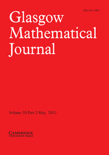
GLASGOW MATHEMATICAL JOURNAL
Elevating the standards of mathematical research and discourse.GLASGOW MATHEMATICAL JOURNAL is a prestigious academic publication in the field of mathematics, published by Cambridge University Press since its inception in 1967. This journal, with an ISSN of 0017-0895 and an E-ISSN of 1469-509X, provides a platform for innovative and high-quality research articles, fostering the advancement of mathematical sciences globally. Covering a broad scope, including various subfields, the journal has been recognized in the top quartile (Q2) of the Mathematics (miscellaneous) category according to 2023 rankings, solidifying its importance and credibility within the academic community. The journal is committed to disseminating rigorous research, making it an invaluable resource for researchers, professionals, and students alike, who are keen to stay abreast of the latest developments in the mathematical landscape. By choosing the GLASGOW MATHEMATICAL JOURNAL, authors ensure their work reaches a discerning audience, while readers gain access to cutting-edge theoretical and applied mathematical insights.

Thai Journal of Mathematics
Fostering knowledge exchange to shape the future of mathematics.Thai Journal of Mathematics (ISSN: 1686-0209) is a distinguished publication within the mathematical sciences, based at Chiang Mai University, Faculty of Science in Thailand. With a focus on diverse mathematical topics, the journal has been actively publishing since 2011 and aims to present original research, reviews, and innovative applications that contribute to the global mathematical community. Despite its current Q4 ranking in Mathematics (miscellaneous) and a modest percentile in Scopus Ranks, it serves as a vital platform for researchers and educators looking to disseminate their findings and engage with emerging trends in mathematics. The journal supports open sharing of knowledge, fostering collaborations and discussions across borders, which is essential for the advancement of mathematical education and research. Researchers, professionals, and students are encouraged to contribute and access valuable insights that shape the future of mathematics.

Korean Journal of Mathematics
Bridging Theory and Application in Mathematics.The Korean Journal of Mathematics, published by the Kangwon-Kyungki Mathematical Society, is an esteemed platform dedicated to advancing the field of mathematics. With an ISSN of 1976-8605 and E-ISSN of 2288-1433, the journal features a range of scholarly articles that emphasize both theoretical and applied aspects of mathematics, catering to researchers, professionals, and students alike. Although it is not open access, the journal maintains a commitment to academic rigor and integrity, ensuring high-quality contributions to the mathematical community. As it converges from years 2021 to 2024, the Korean Journal of Mathematics is poised to enhance its visibility within the Scopus database, currently ranking #354 out of 399 in the general mathematics category, reflecting its potential for growth and impact in the mathematical sciences. With its strategic focus and institutional backing from Kangwon National University, the journal serves as a vital resource for fostering research and dialogue in the ever-evolving landscape of mathematics.
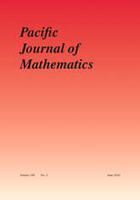
PACIFIC JOURNAL OF MATHEMATICS
Exploring the Depths of Mathematics with Rigorous ScholarshipThe PACIFIC JOURNAL OF MATHEMATICS, established in 1951 and published by Mathematical Sciences Publishers, is a premier peer-reviewed journal in the field of mathematics, renowned for its rigorous scholarship and impactful research contributions. With an HIndex that reflects its sustained academic influence, this journal has been categorized within the Q1 quartile in the field of mathematics (miscellaneous) as of 2023, showcasing its position among the top-tier mathematics journals globally. Although the journal operates under a traditional subscription model rather than an Open Access format, it remains dedicated to disseminating original research that spans various domains within mathematics. Researchers, professionals, and students alike will find the journal's breadth of topics and commitment to quality work instrumental in advancing their understanding and exploration of mathematical concepts. This esteemed journal continues to thrive as a vital resource for the mathematical community through its comprehensive collection of articles from a diverse range of mathematical disciplines, thus maintaining a significant role in shaping the future of mathematical inquiry.

BOLETIN DE LA SOCIEDAD MATEMATICA MEXICANA
Elevating Research in Miscellaneous MathematicsBOLETIN DE LA SOCIEDAD MATEMATICA MEXICANA, published by Springer International Publishing AG, is a pivotal journal in the field of mathematics, particularly recognized for its contributions to the miscellaneous mathematics category, holding a commendable Q2 ranking as of 2023. With an ISSN of 1405-213X and an E-ISSN of 2296-4495, the journal serves as a platform for disseminating high-quality research and innovations from both national and international scholars. Operating from Switzerland, the journal encompasses a broad range of topics within mathematics, supporting the development and communication of mathematical knowledge. Although it is not open access, it remains a respected source for researchers, professionals, and students seeking to deepen their understanding of mathematical concepts and applications. Published continuously and rigorously since its converged years, BOLETIN DE LA SOCIEDAD MATEMATICA MEXICANA plays a crucial role in advancing mathematical discourse and collaboration across disciplines.
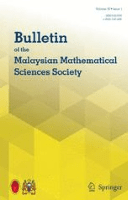
Bulletin of the Malaysian Mathematical Sciences Society
Fostering Global Collaboration in Mathematical SciencesThe Bulletin of the Malaysian Mathematical Sciences Society, published by SPRINGER NATURE, is a prominent academic journal dedicated to advancing the field of mathematics. With an ISSN of 0126-6705 and an E-ISSN of 2180-4206, the journal has established itself as a vital resource for researchers, professionals, and students alike. Based in Singapore, it boasts an impressive Q2 ranking in the miscellaneous mathematics category for 2023, alongside a notable position of 90th out of 399 in the general mathematics Scopus rankings, placing it in the 77th percentile. The Bulletin serves to disseminate innovative research findings, foster mathematical dialogue, and promote collaboration among the global mathematical community, with coverage ranging from theoretical frameworks to practical applications. Readers can expect an engaging mix of original research articles, reviews, and communications that contribute significantly to the evolving landscape of mathematical sciences.

TRANSACTIONS OF THE AMERICAN MATHEMATICAL SOCIETY
Exploring the Depths of Mathematical KnowledgeTRANSACTIONS OF THE AMERICAN MATHEMATICAL SOCIETY, published by the American Mathematical Society, is a premier journal in the field of mathematics that has been contributing to the advancement of mathematical knowledge since 1900. With an ISSN of 0002-9947 and an E-ISSN of 1088-6850, this journal holds a prestigious position in the academic landscape, evidenced by its Q1 rankings in both Applied Mathematics and Miscellaneous Mathematics categories as of 2023. With a Scopus ranking of #97 in General Mathematics and a percentile standing of 75th, the journal is recognized for its rigorous peer-review process and the quality of the research it publishes. Though it does not currently offer open access options, it essentially serves as a vital resource for researchers, professionals, and students seeking critical insights and developments in mathematical theory and applications. The Transactions aim to publish high-quality research articles that foster the exchange and dissemination of ideas, supporting the growth of both theoretical and applied mathematics within the global scholarly community.
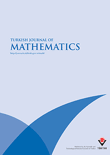
Turkish Journal of Mathematics
Fostering Excellence in Diverse Mathematical DisciplinesTurkish Journal of Mathematics is a prestigious academic publication dedicated to the advancement of mathematical research across a variety of subfields. Established in 1995 and published by the Tubitak Scientific & Technological Research Council Turkey, this journal has built a solid reputation, especially noted for its significant contributions to the field over the years, with its convergence spanning from 1995 to 2002 and again from 2006 to 2024. The journal, which holds a commendable Q2 ranking in Mathematics (miscellaneous) and is positioned in the 66th percentile of Scopus rankings for General Mathematics, aims to disseminate high-quality original research, reviews, and innovative methodologies to advance both theoretical and applied mathematics. Researchers, professionals, and students alike will find invaluable resources within its pages, providing insights that are pivotal for academic and practical applications in mathematics. Although it does not currently offer open access options, the journal remains an essential platform for those looking to engage with the forefront of mathematical inquiry.

Journal of Mathematics
Advancing mathematical frontiers through open access.Welcome to the Journal of Mathematics, a premier open access journal published by Hindawi Ltd, dedicated to advancing knowledge in the diverse realm of mathematics. Since its inception in 2013, the journal has provided a platform for the dissemination of significant mathematical research and applications, achieving recognition in the 80th percentile of the general mathematics category as per Scopus rankings. With a commitment to fostering academic collaboration and accessibility, the journal promotes critical dialogue among researchers, professionals, and students alike. Located in the vibrant academic hub of London, England, the Journal of Mathematics continues to enhance its impact within the mathematical community, as evidenced by its Q3 classification in mathematics (miscellaneous) for 2023. Join us in exploring groundbreaking research and innovations, as we converge towards the future of mathematical sciences through our open access model.